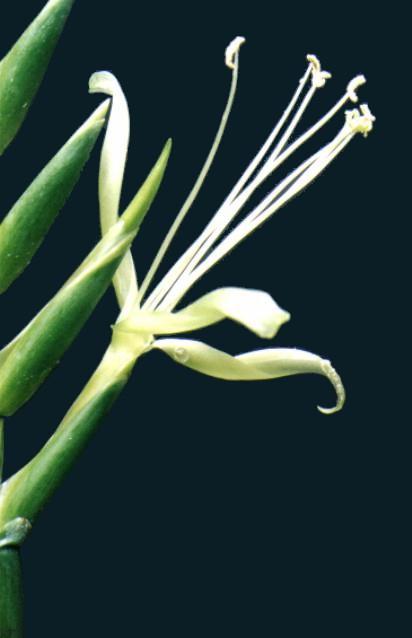
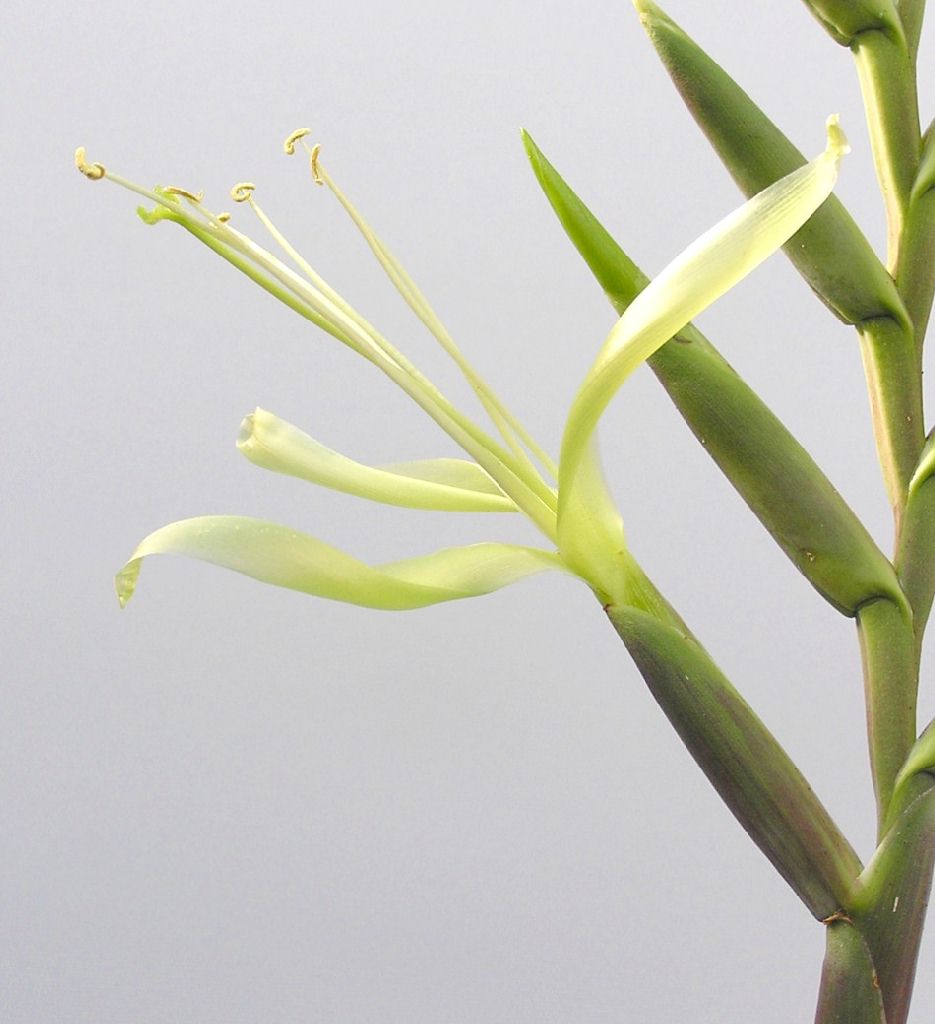
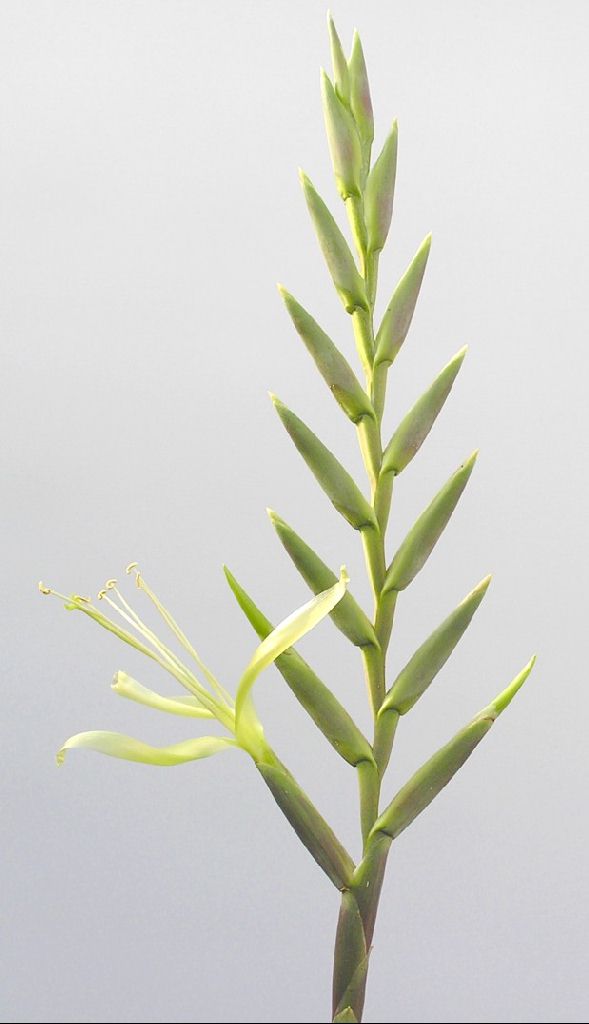
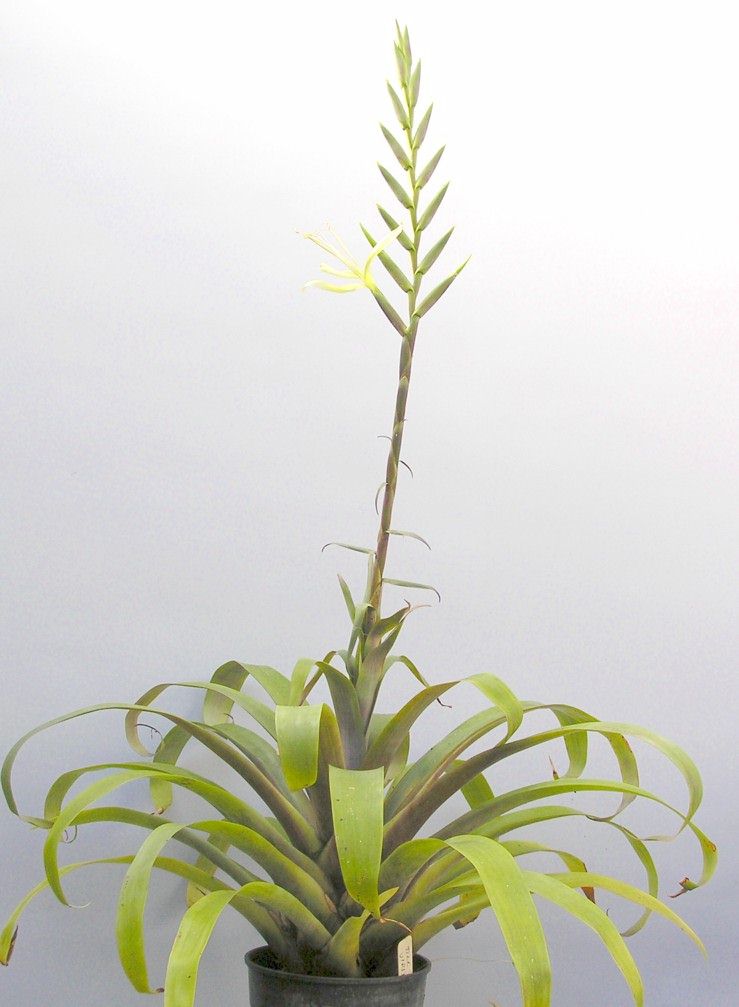
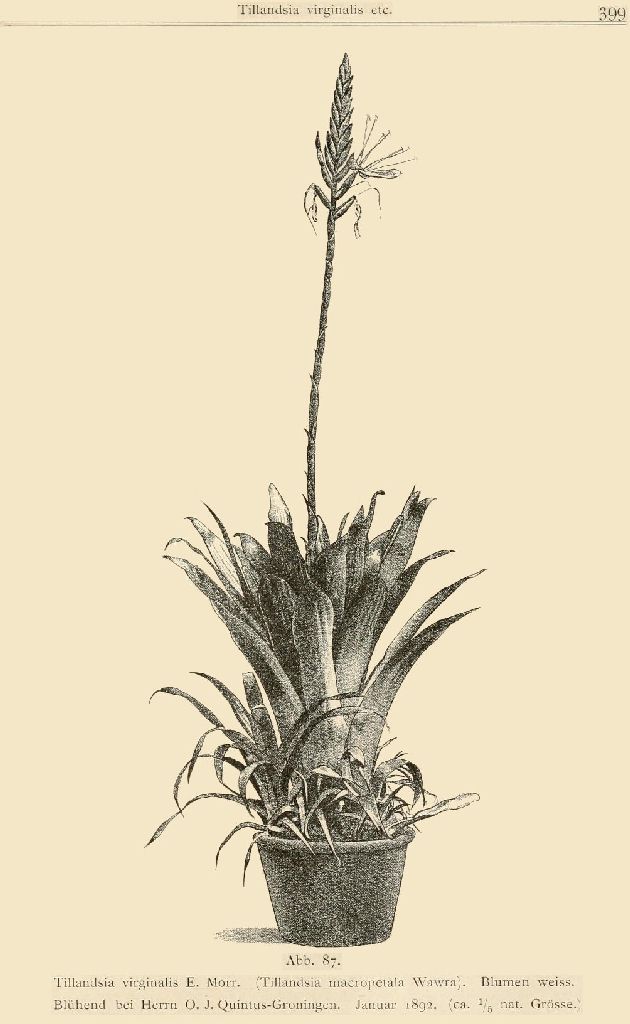
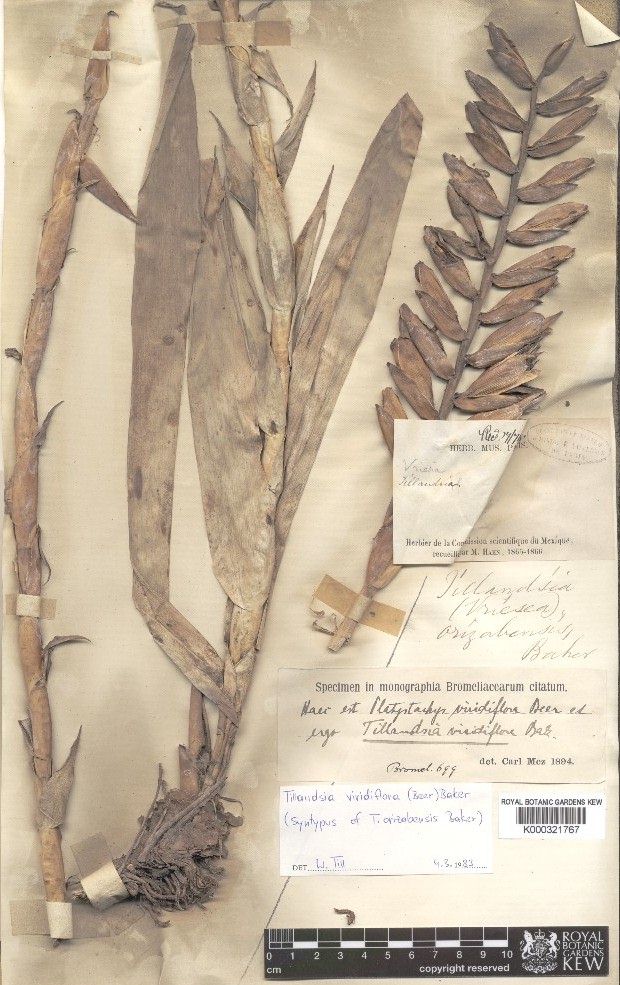
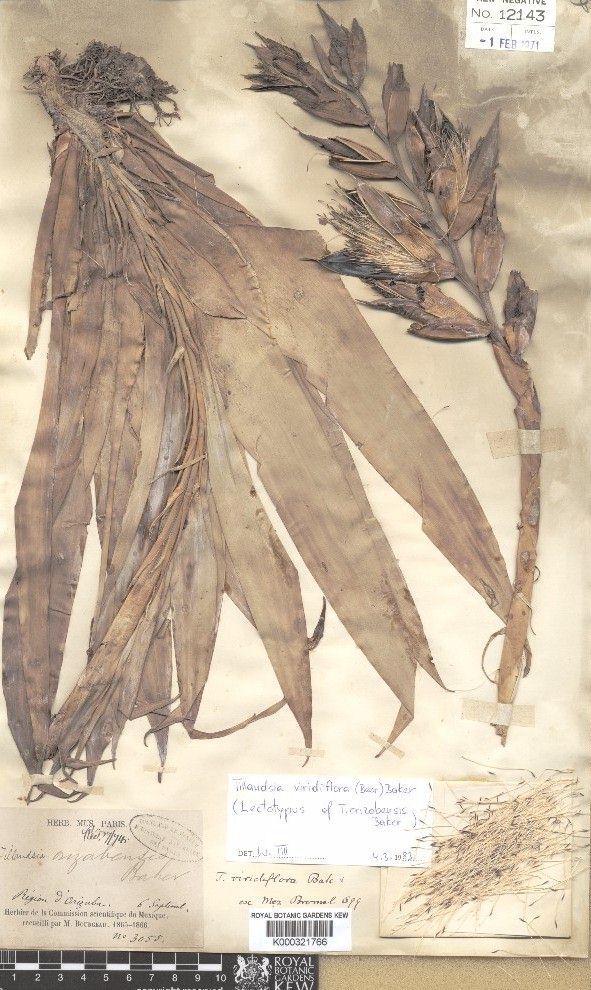

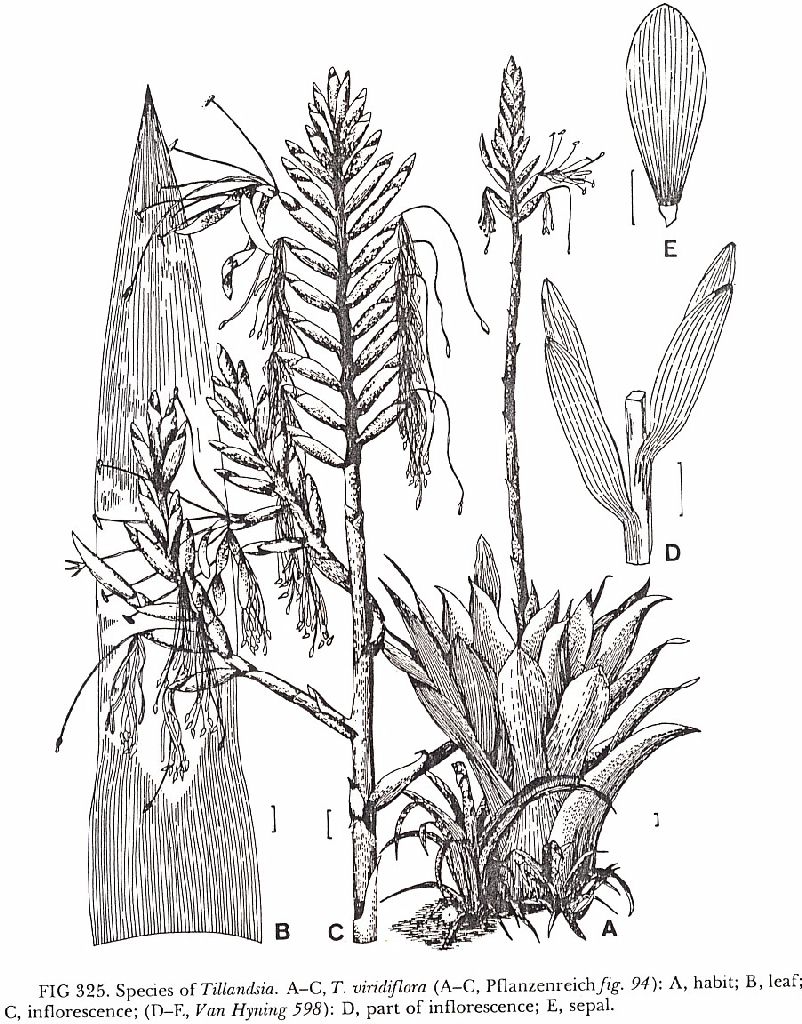
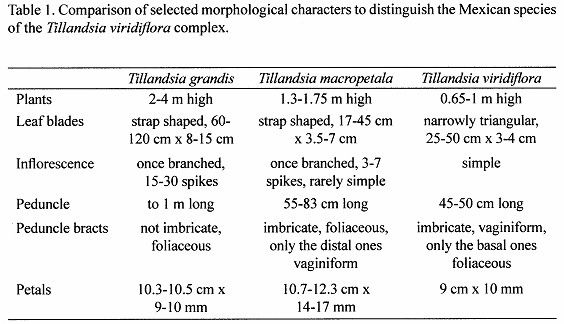
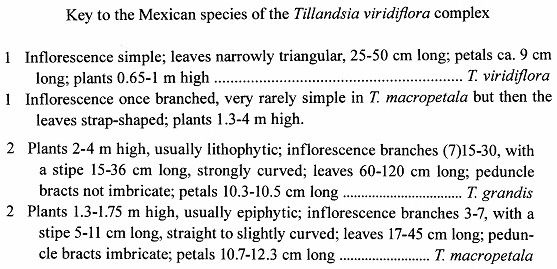
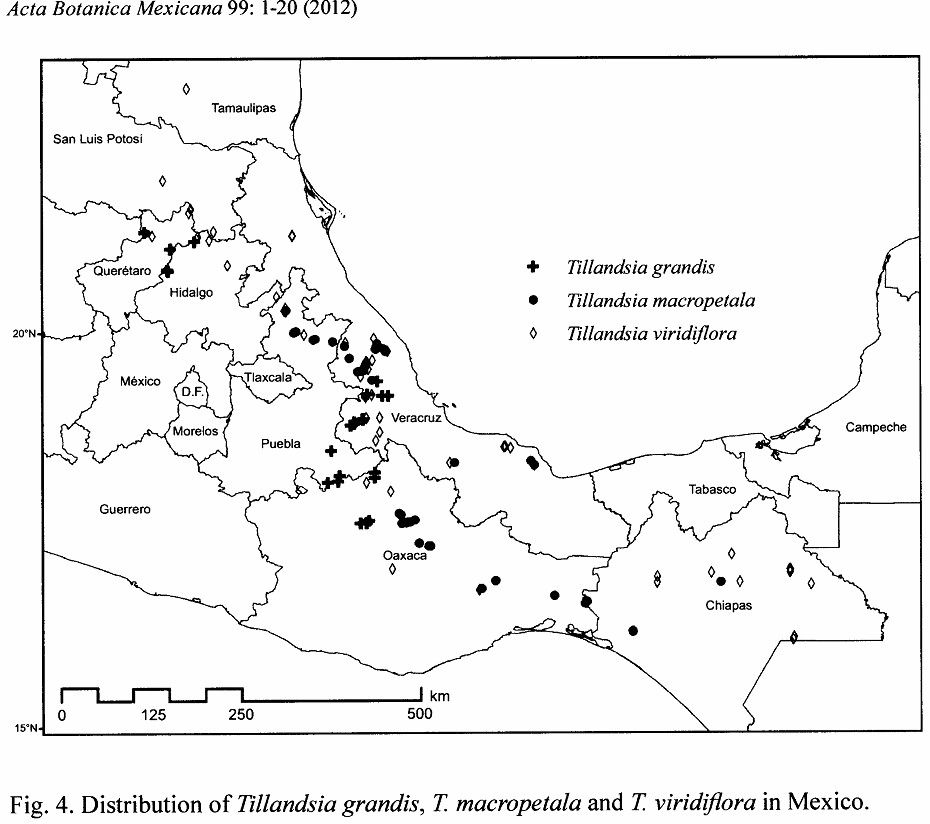
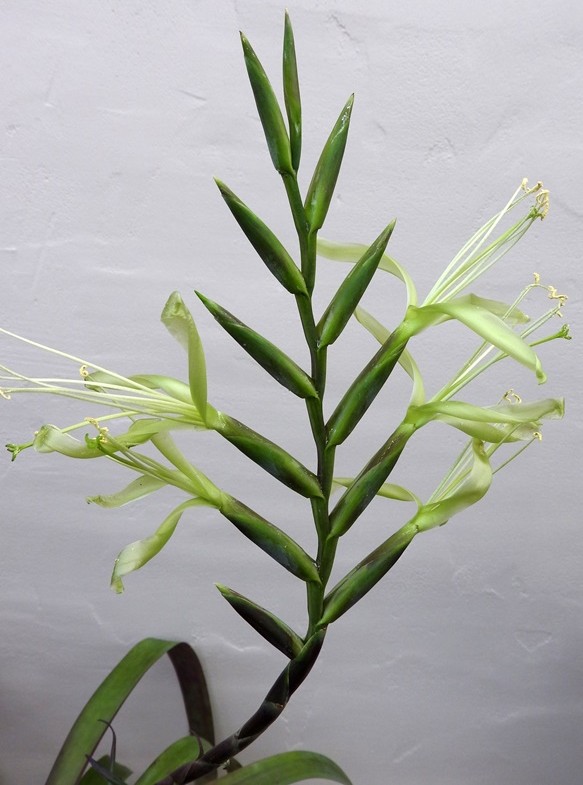
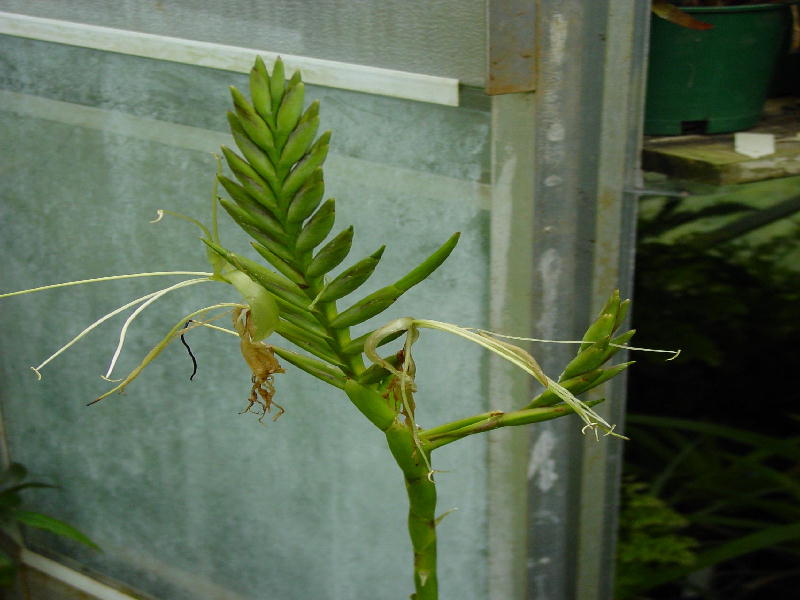
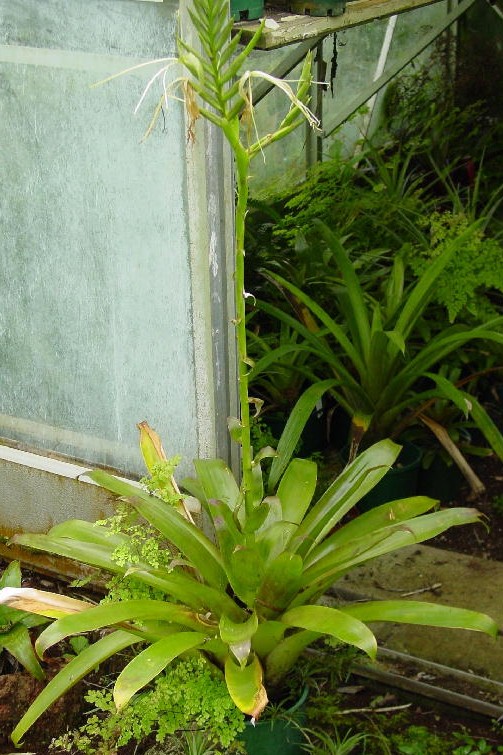
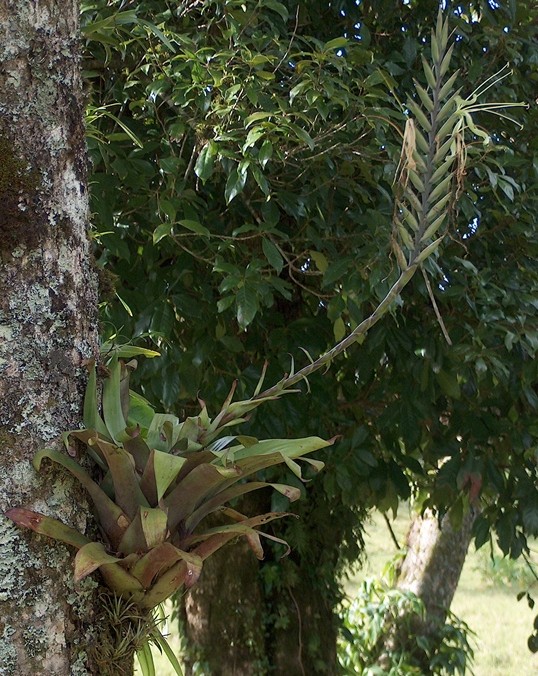
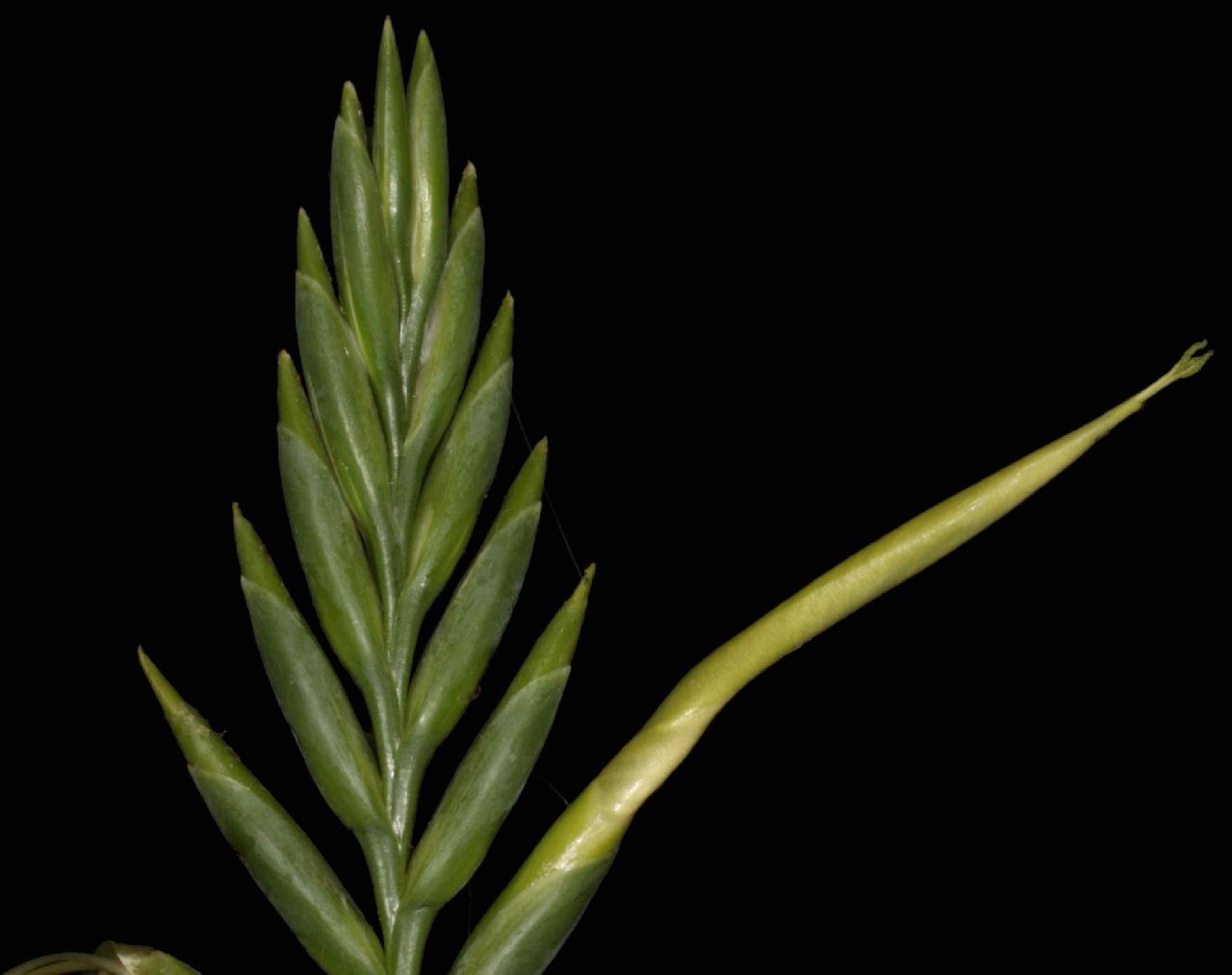
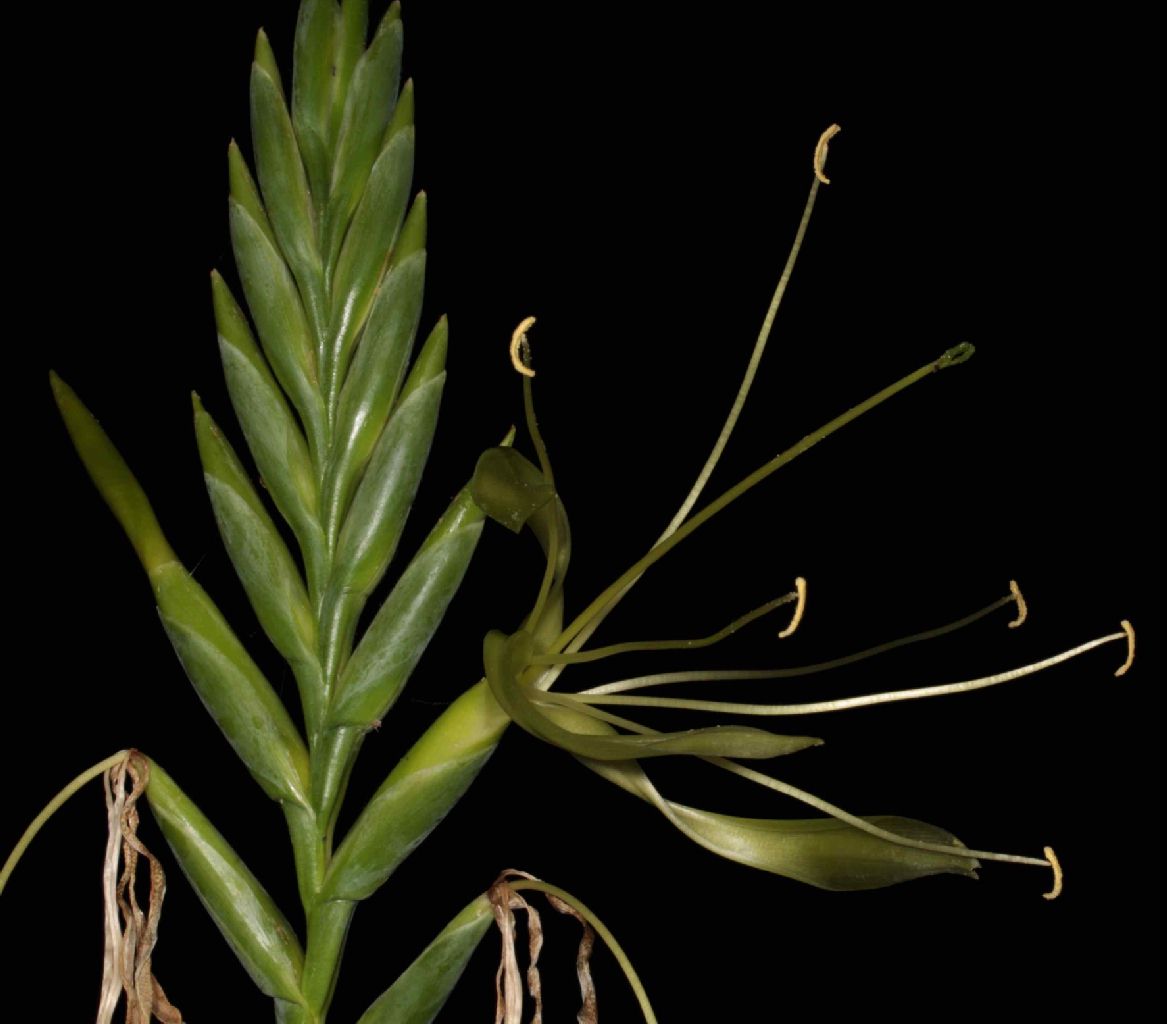
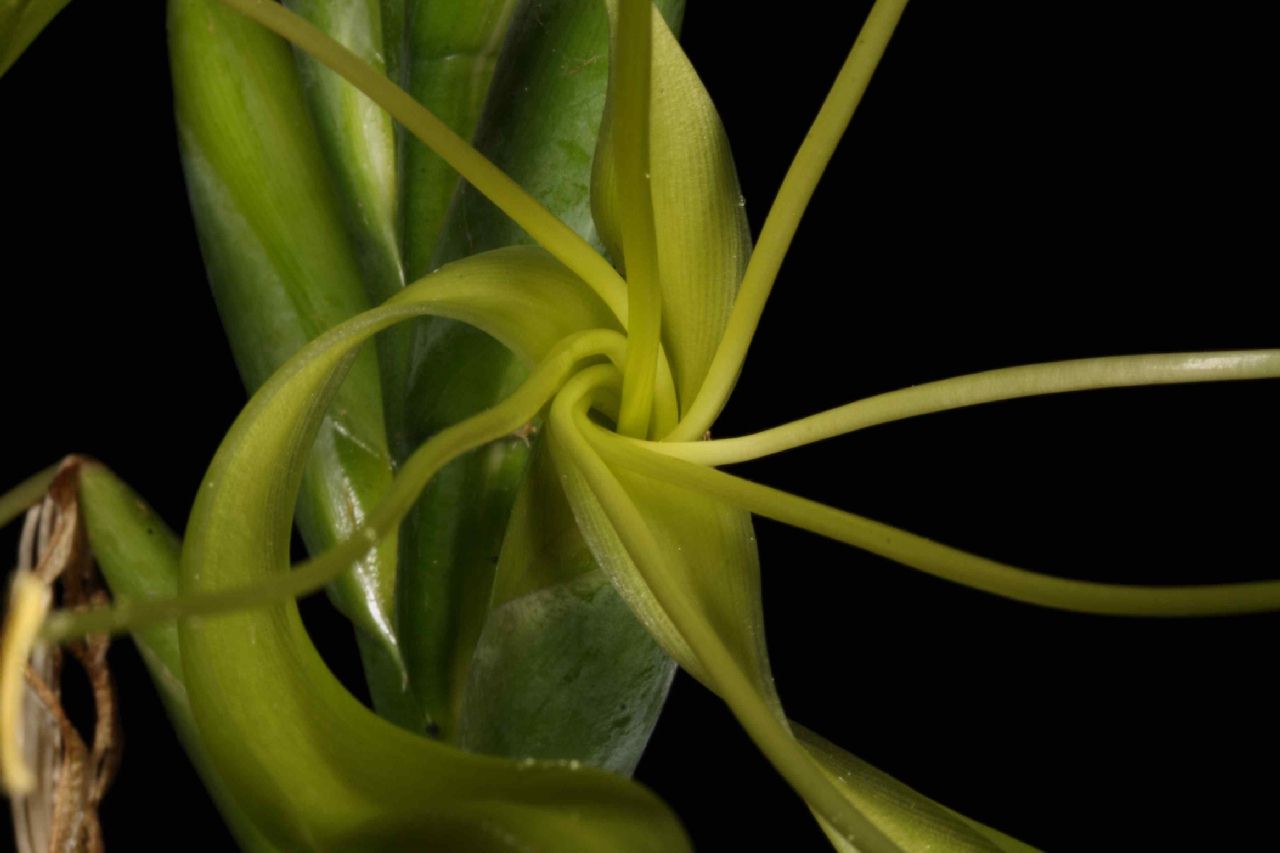
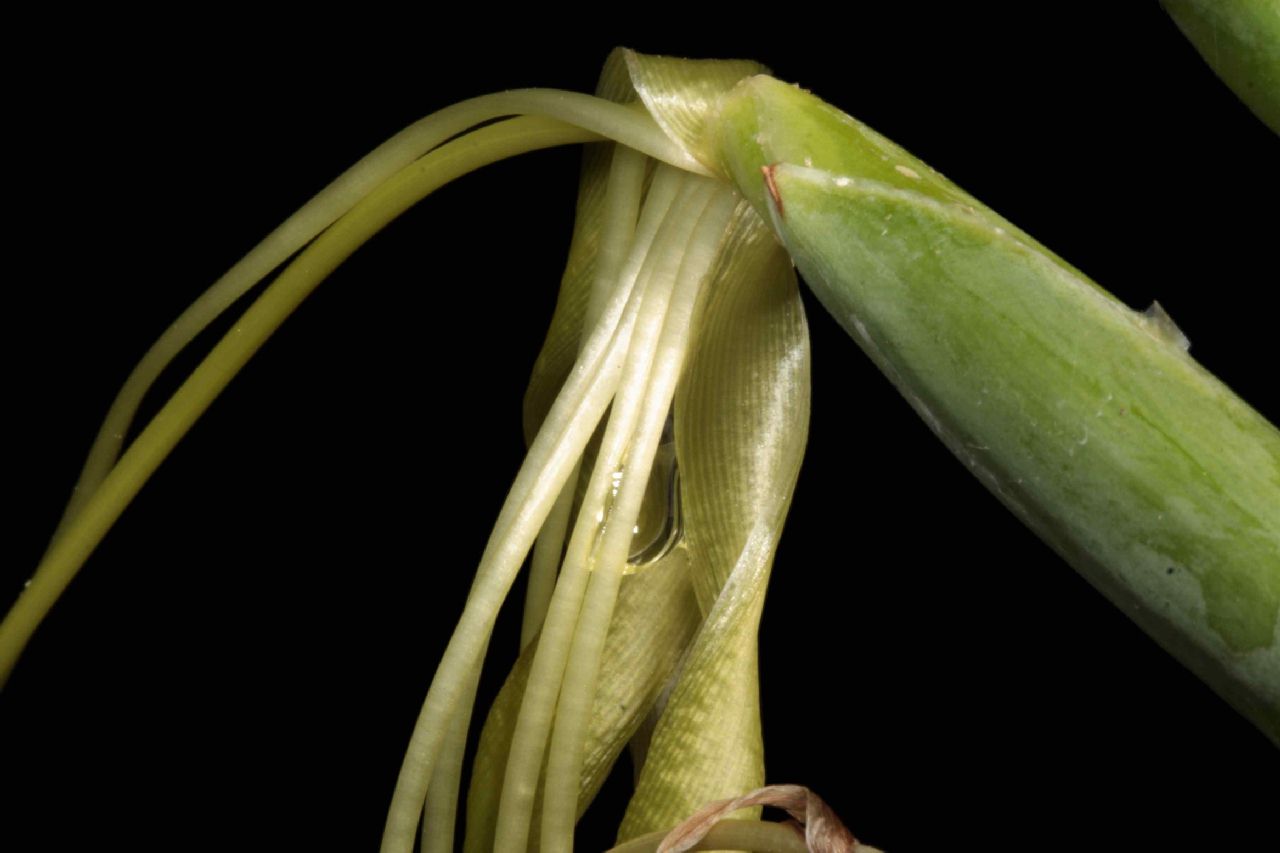
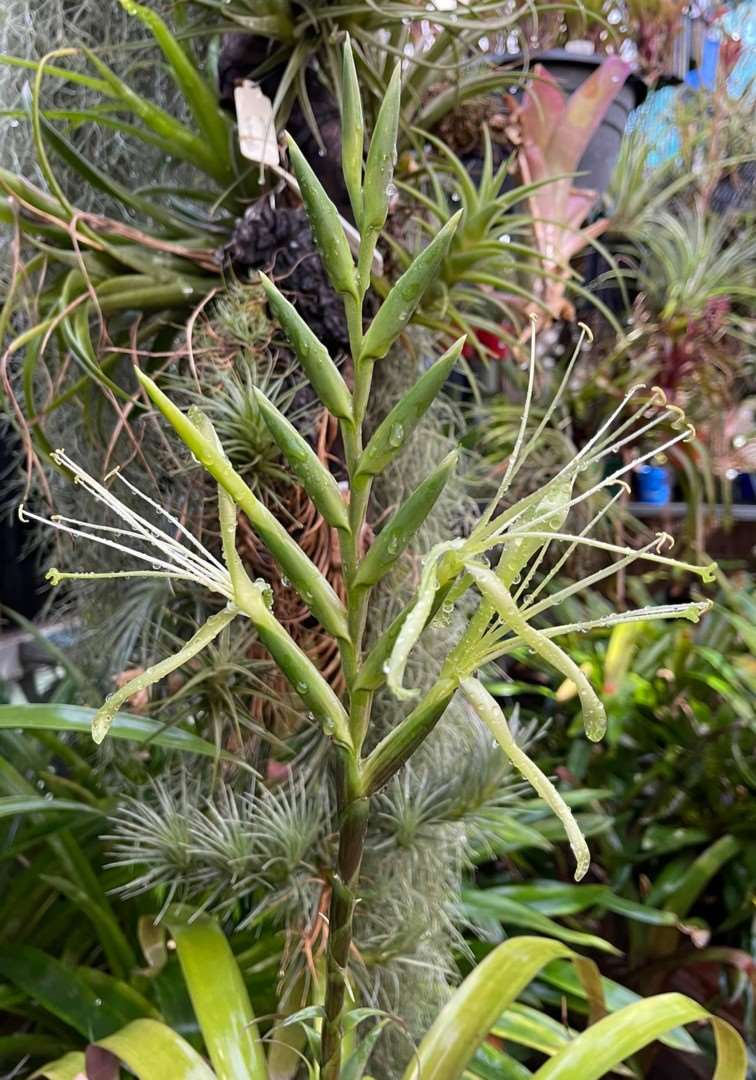

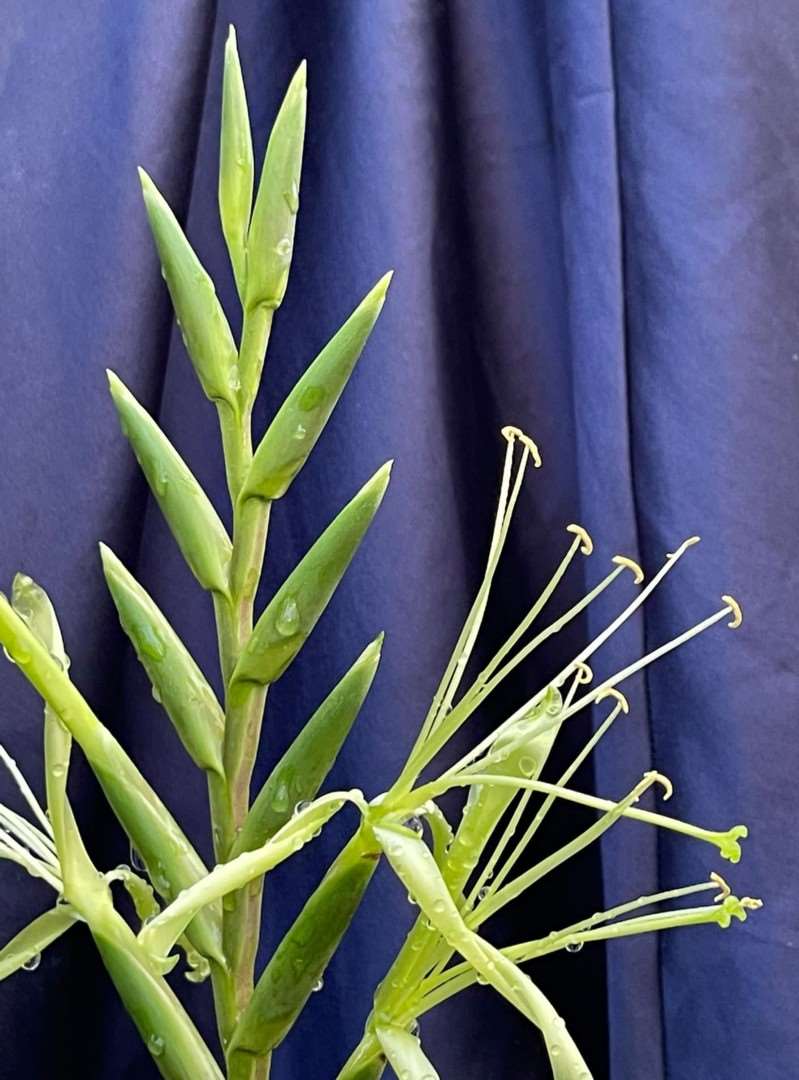
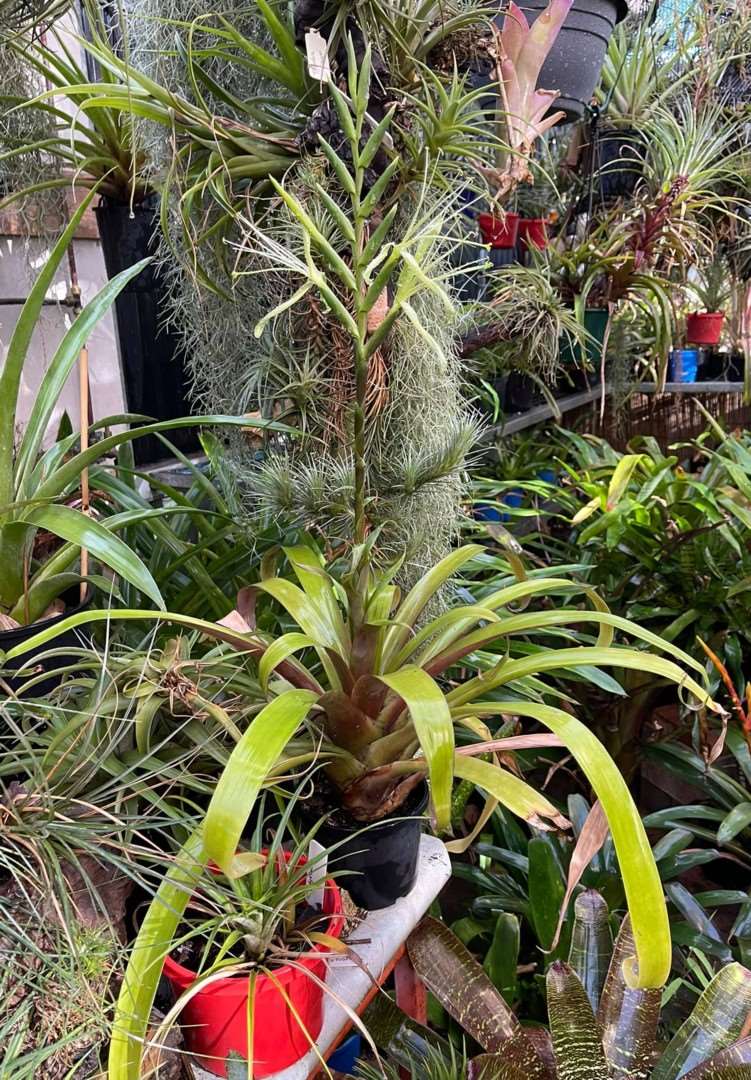
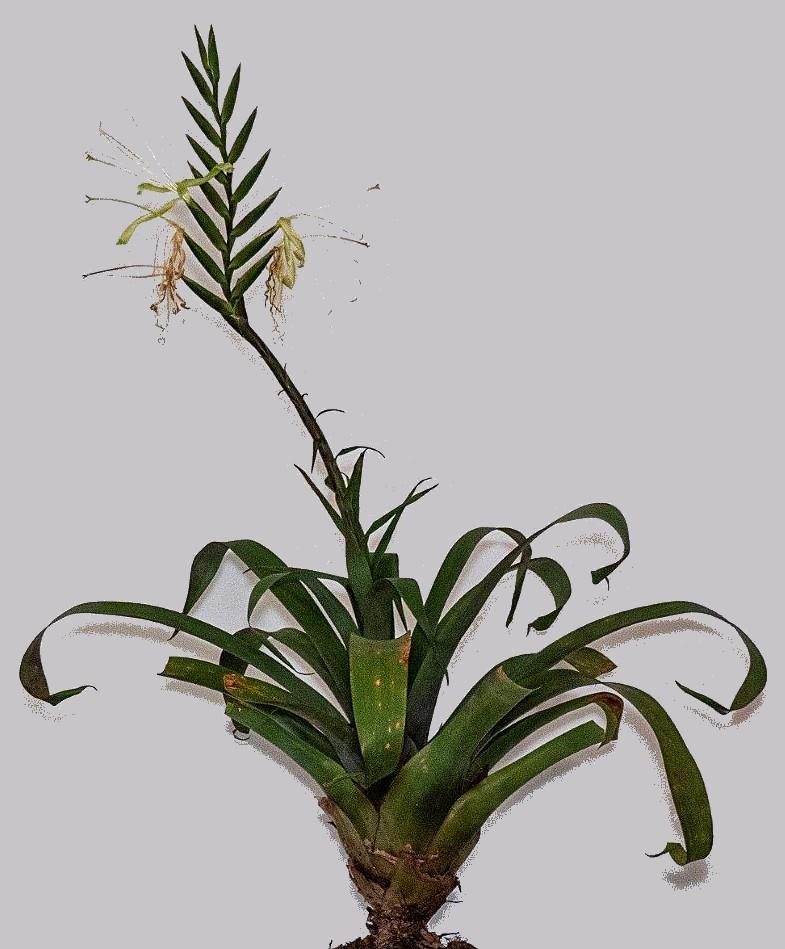
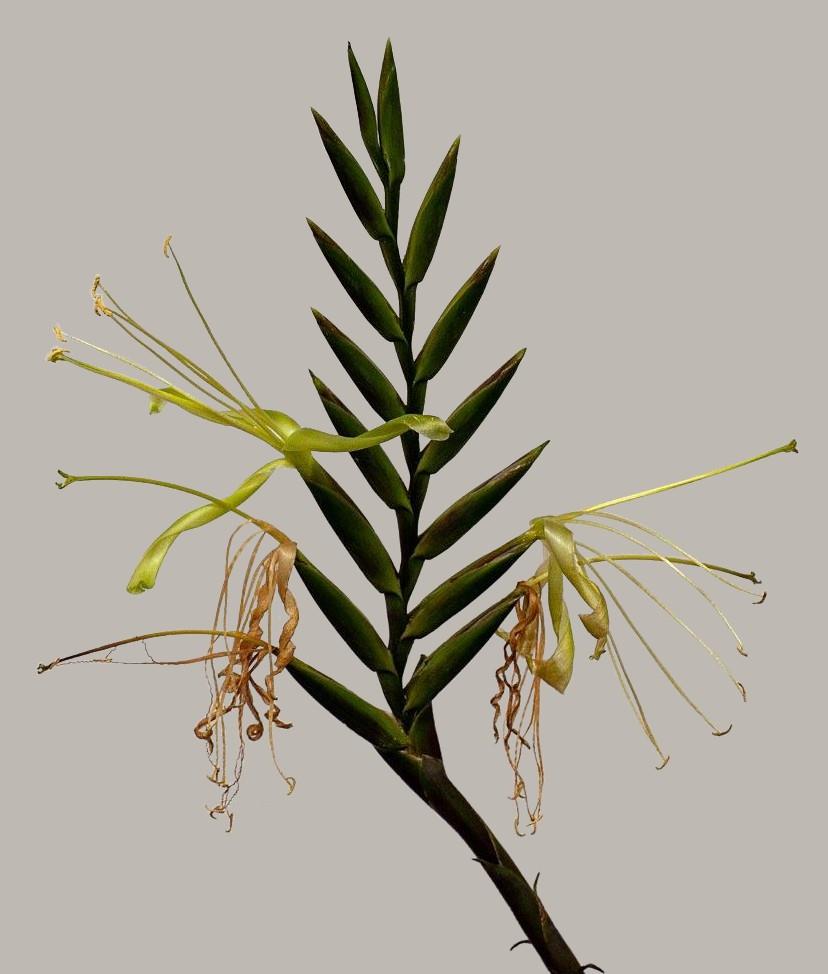
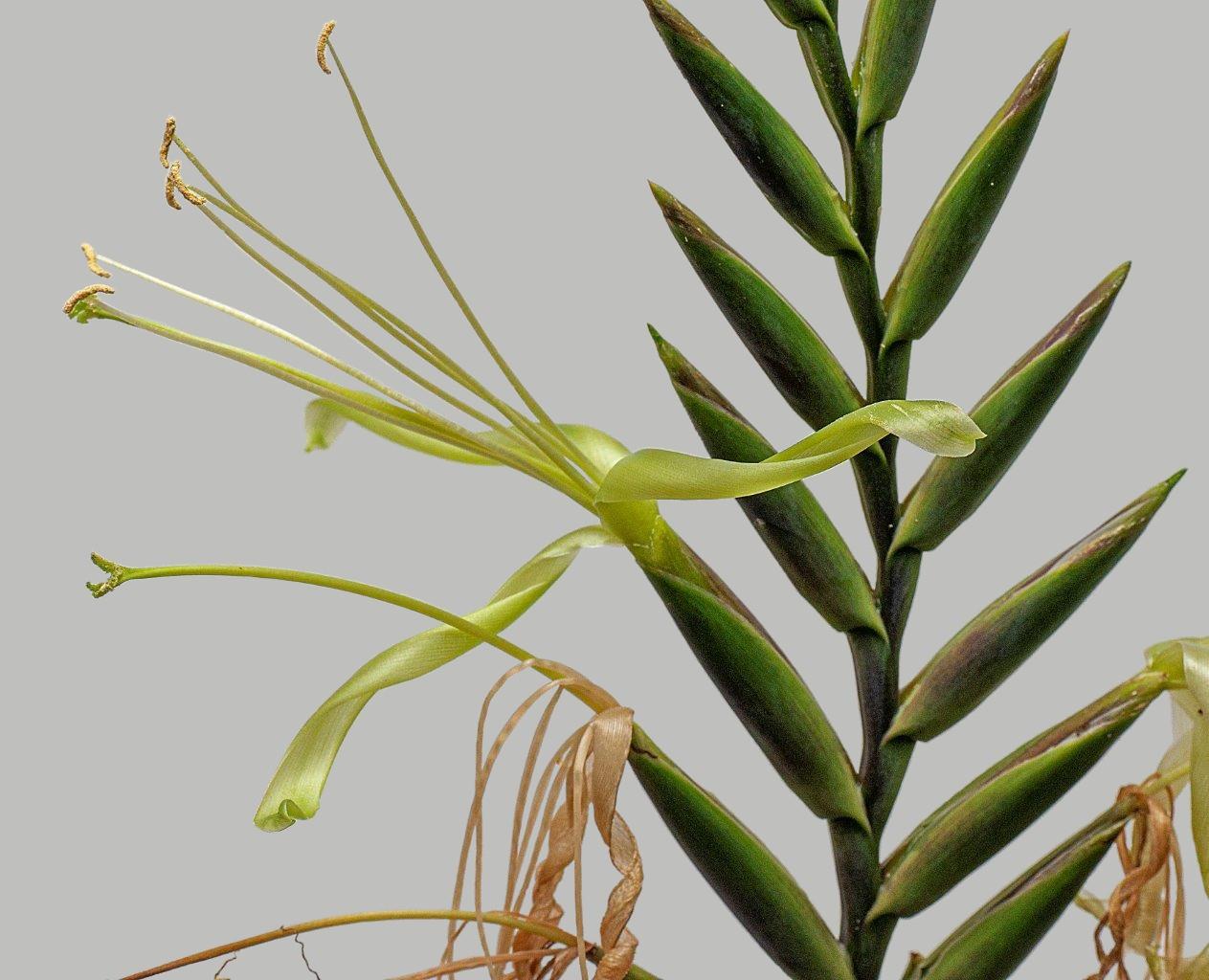
= Tillandsia orizabensis Baker, J. Bot. 26: 105 (1888), Type:—Bourgeau 3055 (holo K!; syn P!); Hahn s.n. (syn K)
= Tillandsia longiflora Sessé & Moc., Fl. Mex. ed. 2: 81 (1894), Type:—Sessé & Mociño s.n. (holo MA)
From Kromer et al in Acta Bot Mex 99: 1-20. 2012
Tillandsia viridiflora (Beer) Baker, J. Bot. 26: 81. 1888.
Platystachys viridiflora Beer, Fam. Bromel. 81-82. 1857. TYPE: Mexico, “diese Pflanze wurde in der Gartnerei des Grafen Attems zu Graz aus Samen gezogen, welchen Herr C. Heller aus Mexico sendete. Sie bluhte das erste Mal im November 1854 und ist jetzt in meinem Besitze” (not located). Figs. 1 C-D, 2 D.
Tillandsia orizabensis Baker, J. Bot. 26:105.1888. TYPE.Veracruz, Orizaba, region d'Orizaba au Borego, E. Bourgeau 3055 (Lectotype
L. B. Smith, 1977
: K! Isolectotypes P!, P!); without precise locality, L. Hahn s. n. (Syntype K!).
Tillandsia longiflora Sesse & Moc., Fl. mexic. 88-89. 1894 "1887"; Fl. mexic. ed.2: 81. 1894. TYPE: Hidalgo, habitat supra arbores montium Huehuetlae. Floret Octobri. Totonaci Tacongxnexanat adpellant, M. Sesse & J. Mocino s n. {No. Cuatrecasas 5459; 196-PB} (Holotype: MA 600161!, MA 606715!) (Blanco Fernandez de Caleya et al., 2010; Stafleu & Cowan, 1985).
Note that T. macropetala not treated as a synonym.
Rosulate stemless epiphytic herbs, flowering 0.65-l m tall, with solitary tank rosettes to 40 cm in diameter.
Leaves numerous;
sheaths brown to light brown, elliptic to oblong, 10-14 cm long, 5.5-6.5 cm wide, densely but inconspicuously punctulate-lepidote on both surfaces;
blades green, slightly glaucous, paler beneath, narrowly triangular, 25-50 cm long, 3-4 cm wide at the base, glabrous on the adaxial surface, sparsely punctulate-lepidote on the abaxial surface, acuminate, erect to ascending.
Inflorescence terminal, erect, simple,
peduncle terete, 45-50 cm long, 5-7 mm in diameter, totally covered by the bract sheaths;
basal peduncle bracts green to reddish, imbricate, vaginiform, only the basal ones foliaceous;
sheaths 3.5-4.5 cm long, blades 1-30 cm long;
spike compressed, oblong to lanceolate, 17-30 cm long, 6-7 cm wide;
floral bracts dark green, glaucous, widely elliptic, 3.2-4 cm long,2-2.4 cm wide, imbricate but the rachis visible after anthesis, smooth to nervate, ecarinate, glabrous outside, sparsely brown punctulate-lepidote inside, apex rounded;
flowers distichous, ascendent, 13-22 per spike, actinomorphic, corolla helicoiform, subsessile;
sepals free, green, oblanceolate, 3-3.4 cm long, ca. 1 cm wide, nervate, ecarinate, glabrous outside, sparsely brown-punctulate lepidote inside, margin hyaline and erose, apex acute;
petals light green, narrowly oblong, strap shaped, twisted, ca. 9 cm long, ca. 1 cm wide, rounded to acute at the apex;
stamens subequal, longer than petals, filaments free, light green to white, filiform, 10-10.5 cm long, anthers green to green-whitish, linear, curved, 9-11 mm long;
ovary green, ovoid, ca. 14 mm long, ca. 5 mm in diameter, style green, filiform, 10-11 cm long, stigma green.
Capsule green, fusiform, rostrate, 5.7-6 cm long, ca. 9 mm in diameter; seeds dark brown, fusiform , ca. 4 mm long, with a white coma 2.2-2.8 cm long.
It is also important to mention that sometimes plants of Tillandsia heterophylla (Fig. 2 B) are confused in herbarium material with T. viridiflora and/or T. macropetala because of the branched inflorescences and overall morphology of the floral bracts. However, in living plants, the flowers of T. heterophylla have infundibuliform and slightly zygomorphic white corollas with included stamens, while the flowers of T. viridiflora and T. macropetala have helicoiform actinomorphic green corollas, spirally twisted petals, and the stamens are exposed. In addition the plants of T. heterophylla are conspicuously glaucous and pruinose.
Finally, we suggest that the name Vriesea billbergiae Lem. (Tillandsia billbergiae (Lem.) Baker) should probably be excluded from the synonymy of T. viridiflora because the original description of the former mentioned the presence of a "gland" at the base of petals: "... {segmentis} internis basi ima glandula maxima rotundato-biloba tenuissima instructis ...". This character is not present in any species of Tillandsia and we think that this name eventually will be assigned to some species of Vriesea Lindl., as this genus in its current circumscription is separated from Tillandsia solely on floral characters (Till, 2000). However, as the description could be wrong, it will be necessary to study the type specimen (Type: Ghiesbreght in Verschaffelt Hortus, Ghent, no date, Mexico) in order to confidently exclude the name.
All three species of the Tillandsia viridiflora complex show a wide distribution in the central and southern states of Mexico (Fig. 4), where they principally occur in or near montane rain or moist pine-oak forests along the slopes of the Sierra Madre Oriental, Sierra de Juarez, and Sierra de Chiapas. However, they can also be found in humid to moderately dry lowland forests. T. grandis occurs at 400 m to 2000 m elevation and grows primarily lithophytically on very steep, inaccessible limestone cliffs, but it is very occasionally epiphytic. T. macropetala can be found at elevations of (150-)1100 m to 2500 m, whereas T. viridiflora occurs from 670 m to 1830 m elevation, both species usually occur as epiphytes and only rarely are found terrestrially. Since the distributions of T. grandis and T. viridiflora range from Mexico to Nicaragua (Beaman & Judd, 1996), it is very likely that a future review of herbarium material considering our identification key also will demonstrate the existence of T. macropetala in Central America, as the latter species is widespread in the southern states of Mexico, and thus probably not endemic to the country.
Their flowering periods are only slightly different, with Tillandsia grandis producing flowers between March and July, whereas T. macropetala and T. viridiflora start blooming in January and last until August (Espejo et al., 2005). In addition to their similar flower morphology and phenology, all three species show inconspicuous greenish inflorescences and a nocturnal anthesis, in contrast to most Tillandsia species that have brightly colored bracts with contrasting flowers which are pollinated by hummingbirds (Gardner, 1986; Benzing, 2000; Kessler & Kromer, 2000). Hietz & Hietz-Seifert (1994) suggest sphingid moths as the most likely visitors, because of their long spreading stamina and pistil exerted from an open actinomorphic flower. However, personal observations by the senior author, combined with the identification of hexose-rich nectar in T. viridiflora by Kromer et al. (2008), indicate bat-pollination, although these do not show the typical chiropterophilous floral syndrome with large zygomorphic, bell-shaped flowers, characteristic of the bat-pollinated species of the genus Werauhia (Kromer et al., 2007). Furthermore, since the flowers of T. macropetala and T. viridiflora are still open during the next morning, they might also be visited by hummingbirds and show a bimodal pollination system.
Protologue
182. T. ORIZABENSIS Baker in Journ. Bot, l888, 105.
Leaves 20 or more in a rosette, lanceolate from an ovate base 2 in. broad, a foot long, 1½ in. broad at the middle, thin, flexible, subglabrous, narrowed gradually to the point.
Peduncle longer than the leaves;
lower bract-leaves with lanceolate free points.
Inflorescence a lax simple spike 6-8 in. long, 2½- 3in. broad; flowers 12-20, erecto-patent;
flower bracts oblong, obtuse, 1 - 1½ in. long, an inch broad.
Calyx half inch longer than the bract;
sepals obtuse.
Corolla not scen. Capsule-valves 2 in. long, ½ in. broad.
Hab. Mexico; province of Orizaba, Bourgeau 3055! Hahn! Differs from T. ensiformis by bracts shorter than calyx.
From Baker 1889
250. T. VIRIDIFLORA Baker in Journ. Bol. 1888, 81.
Platystachys viridflora Beer Brom. 81
Leaves a dozen or more in a utricular rosctte, lorate from an ovate base 2½-3 in. broad, above a foot long, an inch broad at the middle, thin, flexib1e, subglabrous.
Peduncle stiffly erect, 1½-2 ft. long;
bract-leaves with small, free, lanceolate tips.
Inflorescence a dense flat simple spike 8-12 in. long, 2 in. broad, with sometimes a small second one;
flower-bracts oblong-lanceolate, acute, 2-2½ in. long, an inch broad, pale green, glabrous.
Calyx 1½ in. long, Petals greenish, shorter than the stamens.
Hab. Mexico; province of Cordova, Bourgeau 2274! Introduced into cultivation by Carl Heller in 1854.
Allied to T. gladiolifora. It may be the imperfectly described, Vriesea Billbergiae Lemaire in Ill. Hort. xvi. Misc. 91, gathered by Ghiesbreght.
269. T. ORIZABENSIS Baker in Journ. Bot, l888, 105.
Leaves 20 or more in a rosette, lanceolate from an ovate base 2 in. broad, a foot long, 1½ in. broad at the middle, thin, flexible, subglabrous, narrowed gradually to the point.
Peduncle longer than the leaves;
lower bract-leaves with lanceolate free points.
Inflorescence a lax simple spike 6-8 in. long, 2½- 3in. broad;
flowers 12-20, erecto-patent;
flower bracts oblong, obtuse, 1 - 1½ in. long, an inch broad.
Calyx half inch longer than the bract; sepals acute.
Petals not scen. Capsule-valves 2 in. long, ½ in. broad.
Hab. Mexico; province of Orizaba, Bourgeau 3055! Hahn! Allied. to T. ensiformis
3. TILLANDSIA VIRIDIFLORA (Beer) Baker, J . Bot. London 26: 81. 1888. detail from REED S. BEAMAN AND WALTER S. JUDD in Brittonia 48(1) pp1-19. 1996
Platystachys viridiflora Beer, Fam Bromel. 81. 1857.
Described from plants sent alive by Carl Heller to Count Attem, at Gratz. which flowered in Nov 1854 (Baker, 1888)
TYPE. MEXICO Without exact locality. C Heller s n (B?-n v)
Tillandsia orizabensis Baker, Jour. Bot. London 26 105 1888. TYPE Mexico. Orizaba, Bourgeau 3055 (LECTOTYPE: designated by Smith and Downs (1977): K; ISOLECTOTYPE: P-n.v.).
Tillandsia longiflora Sesse & Mocino, Fl. Mex. ed 2. 81. 1894. TYPE. MEXICO. Without definite locality, Sesse & Mocino s. n. (MA-n.v.).
Epiphyte with basal rosette of leaves forming water- and detritus-impounding tank, 0.8-1.2 m high including inflorescence. (Butcher comment – some clones produce normal offsets some grass offsets)
Leaves with distinct sheath and blade;
Sheaths 7-20 X 2.9-11.5 cm, elliptic to ovate, green, occasionally purple-spotted, sparsely to densely covered with peltate, multicellular, radially symmetric, foliar scales with concentric rings of cells and a peripheral wing of 32 cells with distinctly thickened radial walls;
Blade 33.5-51 cm . long, 3.3-10 cm wide at base, narrowly triangular, green, occasionally purple-spotted, the margins entire, the apex acuminate to slightly cuspidate.
Inflorescence a many flowered simple spike or panicle with 1 order of branching and 1-4 primary branches;
Scape terete, 0.9-1.5 cm thick at base, the lower half completely covered by imbricate scape-bracts, the upper half partially exposed due to reduction in size of scape bracts and increase in internode length;
Scape-bracts lower ones differentiated into sheath and blade, the upper scape-bracts not differentiated;
lower scape-bract sheaths 2.5-8 X 1.8-3.5 cm, elliptic to obovate, sparsely to moderately covered with peltate scales on both surfaces, clasping thc scape;
lowcr scape-bract blades 7.4-26 X 1.6-5.8 cm, ovate. erect, sparsely to moderately covered with peltate scales on both surfaces;
the margins entire; the apex, attenuate spreading to recurved;
upper scape-bracts 2.9-5.5 X 1.8-2.9 cm, ovate to elliptic, sparsely to moderately covered with peltate scales on both surfaces, thc margins entire, the apex acute, the base clasping the scape;
Primary branches 9-14 cm long, curved-ascending to erect, with 3-8 sterile bracts below the fertile segment of each branch;
rachis, i.e., the fertile segment of the primary branch, 7-15 cm long, square in cross section, 2-4 mm thick, with 6-22 flowers arranged in 2 ranks:
internode between the two lowest floral bracts 8-19 mm, the distal internodes becoming increasingly shorter:
Primary bracts subtending and loosely clasping the lateral branches, 3.2-5.6 X 1.7-2.6 cm, ovate to elliptic, sparsely to moderately covered with peltate scales on adaxial surface, the abaxial surface glabrous, the margins entire, the apex acute to rounded, the base slightly decurrent:
Floral bracts subtending the flowers, spreading and not overlapping (thus the rachis not concealed completely between floral bracts on the same side of the rachis), 25-51 X 9-26 mm, ovate, sparsely to moderately covered with peltate scales on adaxial surface, the abaxial surface glabrous, the margins entire, the apex rounded, the base decurrent on the sides of the rachis 90° from the sides on which the flowers are borne.
Flowers sessile, slightly zygomorphic; hypanthium completely fused to ovary, 4.5-6 mm long:
Sepals 30-40 X 19-34 mm, obovate, not keeled, connate at the base for 1.5-5 mm, sparsely to densely covered on adaxial surface with peltate scales, the abaxial surface glabrous, the apex ± obtuse;
Petals 71-95 X 10-11 mm, obovate, eligulate, yellowish green, becoming flaccid following anthesis, the apex rounded:
Stamens exserted; filaments terete, 80-105 mm long, ca. 1.2 mm thick: Anthers 9-10.5 X ca. 1.2 mm, often curved. the anther sacs opening by longitudinal slits, the anther attachment versatile, Filaments attaching 2-3.2 mm from base, the base. usually splitting 0.9-1.2 mm up toward the point of attachment, not sagittate: Stigma lobes 3. 4-6 mm long, erect to spreading. if erect then spiraling only slightly or not at all: Style 9-11 cm long;
Ovary 12.8-15 X 4.8--5.9 mm, cryptically ½-inferior. the ovules borne on axile pla-centae in apical portion of the ovary, 8-11 mm up from the ovary base. the basal portion sterile. 3.7-5.5 mm long. composed of soft. brain-like tissue traversed by a multitude of convoluted longitudinal tissures, possibly secretory.
Capsules 63-69 X ca. 10 mm. Ovules with a minute apical appendage.
Seed body 3-4 X 0.5-0.8 mm, the basal coma 22-31 mm long, the apical appendage up to 0.3 mm long, not divided into a coma.
Distribution and Ecology. Tillandsia viridiflora occurs at (360) 900-1600 m elev ., from central Mexico (Hidalgo) to Nicaragua (Fig. 6; Smith & DOWIlS, 1977). The species is fairly common as all epiphyte in moist montane pine-oak-sweetgum forests. It also survives well when these habitats are converted into coffee plantations. Rarely, T. viridiflora occurs terrestrially on steep, moist limestone cliffs.
Additional specimens examined. BRITISH HONDURAS. Camp 33, B.H.-Guatemala survey, 2700 ft, Schipp S-811 (GH).
HONDURAS Dept de Ocotepeque: Rd. from Yaruchel to Belen Gualcho, 1500-2000 m, Nelson et al. 3945 (ENCB, MO).
MEXICO. Chiapas: Without definite locality, Read & Desautles 84-103 (US); 13 km N of Berriozabal nr. Turipache and Finca El Suspiro, municipio of Berriozabal, Breedlove 31519 (ENCB); SE of Cerro Baul, 16 km NW of Rizo de Oro along logging rd. to Colonia Figaroa, municipio of Cintalapa, Breedlove 24770 (ENCB). Hidalgo: 3 km NE of Chapulhuacan, Rzedowski 12322 (ENCB); Mirador, Liebmann s.n. 1841-43 (UC). Oaxaca: 39 km SW of Valle Nacional, on rd. to Oaxaca, Rzedowski 33348, 33826 (ENCB); Chinantecas Mts., Vista Hermosa, 20 mi SW of Valle Nacional, Van Hyning 5959 (US). Puebla: 3 km W of Xicotepec de Juarez, Gutierrez 168 (ENCB); Cascada de La Gloria, nr. Apulco, municipio de Zacapoaxtla, Rzedowski 31850 (ENCB); Agua de Obispo, municipio de Teziutlan, Ventura 1061 (ENCB). San Luis Potosi: Las Canoas, Pringle 5100 (GH); Cerro de San Francisco, Manry 6258 (F, GH). Veracruz: 6 km NW of Santa Rita, municipio de Yecuautla, Vazquez V-1878 (ENCB, MEXU); Alseseca, municipio de Atzalan, Ventura 187 (ENCB); El Mirador, Purpus 15763 (UC); El Haya, municipio de Yecuautla, Ventura 3095 (ENCB); Jalapa, Schiede & Deppe s.n., May 1829 (B, US); 2.5 km NE of Jilotepec along rd. to Naolinco, municipio de Jilotepec, Diggs & Nee 2776 (NY), Beaman 623, 624 (FLAS); 2 km S of San Andres, nr. Orizaba, 1560 m, Beaman 625 (FLAS); Jilotepec, 5000 ft, Van Hyning 598 (US); Los Capulines, nr. Paz de Enriquez, ca. 8 km N of Chiconquiaco, municipio de Yecuatla, Taylor, Nee & Castillo 139 (F); nr. Coatepec, Foster & Van Hyning 3002 (US); El Esquilon, Cerro del Quajilote, Castillo C. 411 (F); Guayuato, Lugis s n., Oct 1899 (US); Orizaba, Hahn s. n. (GH); Orizaba, 2500-3000 ft, Kubisch 14 (US); Tepetzintla, Sierra Otontepec, Castillo C, Nee & Benavides 2542 (F); Tepetzintla, Sierra de San Juan Otontepec, Castillo C., Nee, & Benavides 2384 (F); Mirador. Liebmann. s.n., 1841-43 (C).
Tillandsia viridiflora (Beer) Baker, Jour. Bot. London 26: 81. 1888. As to basionym, not as to description and citation. detail from S&D p1020-2
Platystachys viridiflora Beer, Bromel. 81. 1857.
?Vriesea billbergiae Lemaire, 111. Hort. 16(Misc.): 91. 1869. Type. Mexico, Ghiesbreght in Verschaf¬felt Hortus, Ghent (n v).
Tillandsia macropetala Wawra, Wiener III. Gart. 12: 241, Fig. 50. 1887. Type. Vienna Hortus ex E. Morren s n (n v). Identified by description and illustration.
? Tillandsia billbergiae (Lemaire) Baker, Jour. Bot. London 26: 48. 1888.
Tillandsia orizabensis Baker, Jour. Bot. London 26: 105. 1888. Lectotype. Mexico, Orizaba, Bourgeau 3055 (K, P).
Tillandsia longiflora Sesse & Mociflo, FI. Mex. ed. 2.81. 1894. Type. Mexico, Sesse & Mocino s n (MA, n v).
Tillandsia virginalis sensu Wittmack, Gartenflora 44: 398, figs. 87, 88. 1895; non E. Morren, 1880.
Vriesea macropetala Hortus, Revue Hort. 69: 336. 1897.
Tillandsia grandis sensu Mez, Pflanzenreich IV. Fam.32: 455.1935; non Schlechtendal, 1843; in part as to Gartenflora citation and as to fig. 94.
Plant stemless, flowering 5-18 dm high.
Leaves utriculate-rosulate, 35-65 cm long;
Sheaths distinct, amply elliptic, nearly covered with fine appressed brown scales;
Blades ligulate, acuminate, 3-5 cm wide, chartaceous when dry, glaucous-green or wine red, obscurely punctulate-lepidote on both sides or glabrous above.
Scape erect, stout, exceed¬ing the leaves;
Scape-bracts imbricate and wholly covering the scape, elliptic, the lower foliaceous-laminate, the upper rounded and more or less apiculate.
Inflorescence simple or laxly bipinnate from a few spikes;
Axis bracteate like the upper scape;
Primary bracts like the upper scape-bracts, about equaling the short bracteate sterile bases of the spikes;
Spikes linear, laxly many-flowered, the terminal or solitary one erect, 25-30 cm long, the lateral curved-ascending, 20 cm long;
Rhachis nearly straight, angled with prominent lines decurrent from the floral bracts, glabrous.
Floral bracts broadly elliptic, rounded, 35--40 mm long, exceeded by the sepals and much exposing them, ecarinate, nearly even, coriaceous;
Pedicels 10 mm long, stout.
Sepals equally very short-connate, elliptic, 35-39 mm long, ecarinate, coriaceous, nerved, glabrous;
Petals linear, to 9 cm long, green (! Mez) or cream-white, pendent at anthesis, shorter than the stamens;
Capsule fusiform, to 55 mm long.
Type. Mexico, without exact locality, Heller in Attems Hortus, Graz (B ? nv). Identified by description.
DISTRIBUTION. About 900-1200 m alt, central Mexico to Nicaragua.
MEXICO. SAN LUIS POTOSI: Tamazunchale, May 1891, Maury 6258 (F, GH); Las Canoas, 17 Oct 1891, Pringle 5100 (GH). VERA CRUZ: Mirador, Oct 1841, Liebmann s n (C); Aug 1930, Purpus 15763 (UC); Orizaba, Botteri 65 (GH); Serra Atazac, Duges 20 (GH); Coatepec, 11 Apr 1957, Foster & Van Hyning 3002 (GH); Jilotepec, 30 Mar 1959, Van Hyning 598 (US). GUATEMALA. SAN MARCOS: Volcan Tajumulco, 7 Mar. 1940, Steyermark 37070 (F). NICARAGUA. MATAGALPA: Santa Maria de Ostuma, Feb 1963, William et al 24763 (F).
Tillandsia viridiflora (Beer) Baker, var. variegata W. Seaborn, JBS 29 : 182 . 1979
A var. viridiflora foliis variegatis differt.
Type: Cultivated W. Seaborn s n (US).
In cultivation this plant picks up a dark red diffusion. The plant was found in the Jalapa, Vera Cruz, Mexico area, 1968.
Detail from Baker 1889
269. T. ORIZABENSIS Baker in Journ. Bot. 1888, 106.
Leaves 20 or more in a rosette, lanaeolate from an ovate base 2 in. broad, a foot long, 1½ in. broad at the middle, thin, flexible, snbglabrous, narrowed gradually to the point. Pedunole longer than the leaves; lower bract-leaves with lanceolate free points. Inflorescence a lax simple spike 6-8 in. long, 2½ -3 in. broad; flowers 12-20, erecto-patent ; flower-bracts oblong, obtuse, 1-1½ in. long. Calyx ½ in. longer than the bract ; sepals oblong, obtuse. Petals not seen. Capsule-valves 2 in. long, ½ in. broad.
Hab. Mexico ; province of Orizaba, Bourgeau 3055 ! Hahn ! Allied to T. ensiformis.